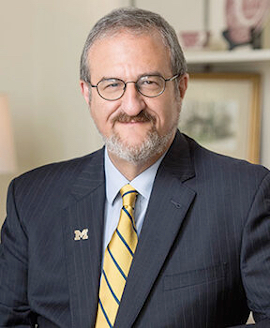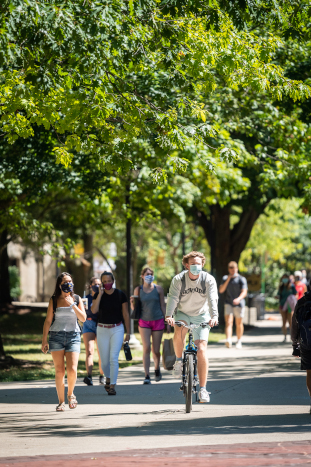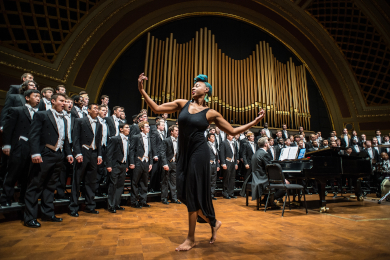President’s Message

At the heart of our commitment to the public good is our mission. It grounds all of our activities and aspirations. This year, it has been a beacon amid a sea of uncertainty — as it has guided our work to serve the public through education, research, service and patient care.
Our focus on U-M’s public mission has ensured that we are making a difference for millions of people:
- We are the opportunity for nearly 65,000 students across our three campuses.
- We are the hope that comes from $1.62 billion in research productivity.
- We are life-saving cures and treatments, new levels of understanding and advocates for justice, knowledge, peace and public health.
- We are saving lives on the front lines of the pandemic in U-M hospitals and clinics.
We also are upholding University of Michigan excellence. U-M maintained its ranking as the 15th top university in the world for the fourth year in a row in the Times Higher Education World Reputation Rankings.
Our nation’s ability to respond to a pandemic demands the level of disciplinary breadth that we pride ourselves on at U-M. We all have seen the effects of the pandemic as they relate to medicine, public health, business, public policy and education. At the same time, other disciplines have engaged deeply and importantly, whether by using technology to bring the arts to people remotely in their homes, or examining the disparities among people that are being exacerbated by this virus.
The strength of our community has been essential to our ability to maintain our mission during the pandemic. This year, U-M donors have given $440 million in payments and cash, as detailed in the report of the vice president for development. Our donors’ outstanding generosity helped us be more responsive to multiple aspects of the pandemic while adding to our ability to serve our communities and the world at large.
INNOVATIVE EDUCATION

This year, providing a high-quality educational experience in a safe environment for each of our students remained a primary focus, and our long track record of financial strength and investments in cutting-edge technology has ensured the continued success of our academic programs.
Our undergraduate enrollment increased slightly on the Ann Arbor campus this fall, even during a global pandemic, a national recession and international travel restrictions. The campus again set a record for the number of applicants for the first-year class. And more than 1,600 students from low-income families received a total of $19 million in institutional and federal support to cover the entire cost of tuition and fees through our Go Blue Guarantee.
In March, U-M transitioned to remote classes and reduced density on the campus to help prevent the spread of COVID-19. While this was a difficult and stressful time for our community, it was made easier by our leadership in innovative teaching. Multiple units across U-M implemented or developed tools to facilitate remote teaching and learning.
Our Center for Academic Innovation is another example of our leadership. We created the center in 2019, following the 2016 launch of our Academic Innovation initiative. Its goals to extend academic excellence, expand public purpose and end educational privilege have taken on much greater importance during the pandemic.
Even before COVID-19, our School of Education had partnered with the center to create an online certification program for K-12 educators on integrating technology into classroom teaching so that it adds value to learning. The program focused on quality pedagogy that underpins effectively using technology in the classroom, rather than the more common approach of training teachers how to use specific technologies.
The center later launched its World & COVID-19 Collection, a portfolio of learning experiences that will help learners understand the pandemic’s complexities and challenges from a public health perspective. The collection’s interrelated topics include virus biology, public safety, personal health and the societal implications and systemic inequalities that exacerbate the effects of the pandemic.
IMPACTFUL RESEARCH
Science and research are in high demand during this pandemic, and our faculty have responded. The University of Michigan reported $1.62 billion in research volume during the fiscal year, achieving the same total research volume as fiscal year 2019 despite temporarily ramping down noncritical laboratory research during part of the pandemic.
The success demonstrates the commitment of our researchers and our diligent work to move our mission forward, with rigorous safety protocols.
This year, U-M research spurred a record 31 startups and 522 inventions. Our research enterprise also boosts the state and national economies by creating jobs and driving global competitiveness.
The Institute for Research on Innovation and Science reported that U-M contributed $5.6 billion to the national economy through vendor contracts and subcontracts between FY ’02 and FY ’19, $1.8 billion of which was spent in Michigan.
COVID-19 was a major component of our research. Our researchers are pioneering medical treatments for coronavirus infection and advising decision-makers across the country on the societal, economic and public health impacts of the pandemic.
In the first six months of the pandemic, U-M researchers submitted more than 800 proposals to pursue COVID-related research, launched more than 320 COVID-related research projects and authored more than 600 COVID-related publications, advancing our knowledge of the virus and its impact on our communities.
EXCELLENCE IN THE ARTS

No university can be truly comprehensive, or excellent, without strong programs in the arts, and a deep commitment to sharing them — and their many benefits — across the breadth of the academic enterprise and with the broader public. U-M’s arts programs, museums and galleries have taken our mission to heart during the pandemic and demonstrated their importance to our community and beyond.
Our Institute for the Humanities created a livestreaming video series, “House Calls: Virtual Studio Visits with Michigan Artists in a Pandemic,” to bring 10 artists across the state to the public via video chat. U-M’s art and performance organizations and its libraries and galleries have many exhibits, performances, speakers and other enriching resources online, and they launched new ways to support student learning, academic research and engagement with the public.
None of this would be possible without the university’s sound financial position, as detailed in the Chief Financial Officer’s Report.
The COVID-19 pandemic has upended life throughout the United States and all around the globe. It has revealed once again the importance of a leading research university and the need for educated, creative and talented people to rise to confront a major societal problem.
Our university was originally envisioned as a resource for the people of Michigan – and we have been proud to deliver on our mission amidst many challenges, through education, research and patient care that is both innovative and responsive to the needs of our communities.
Sincerely,

Mark S. Schlissel
President
